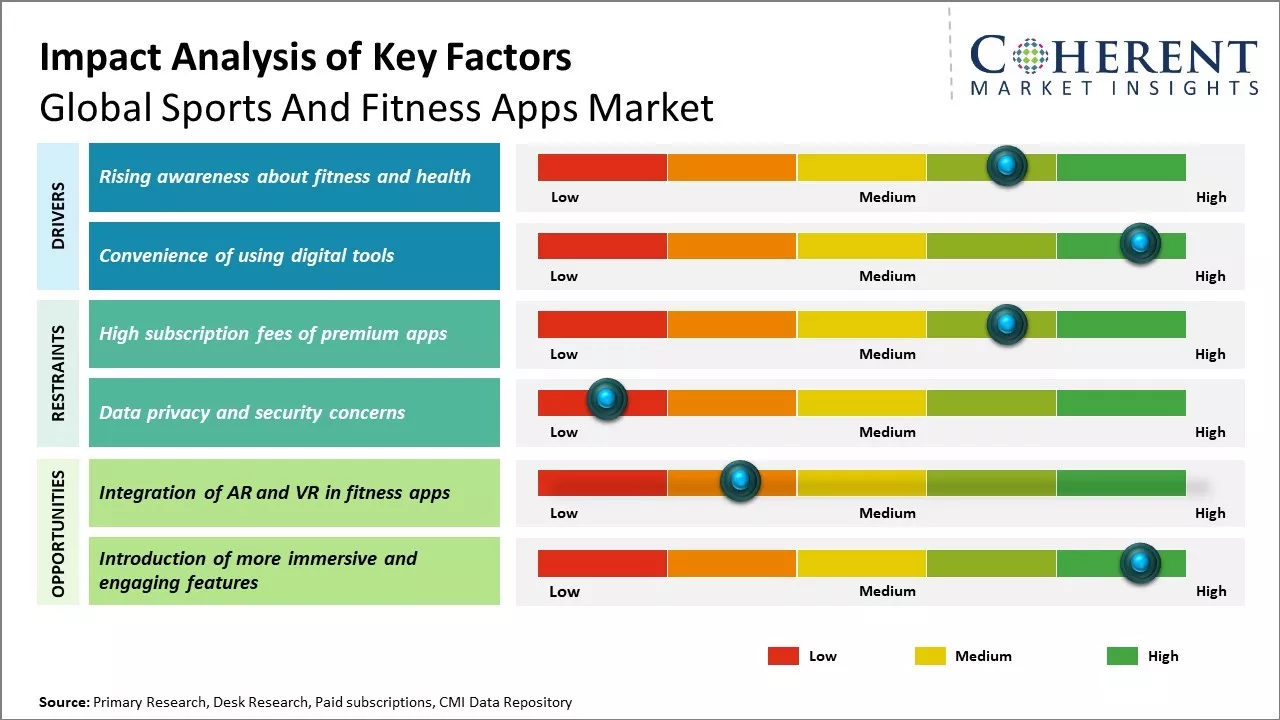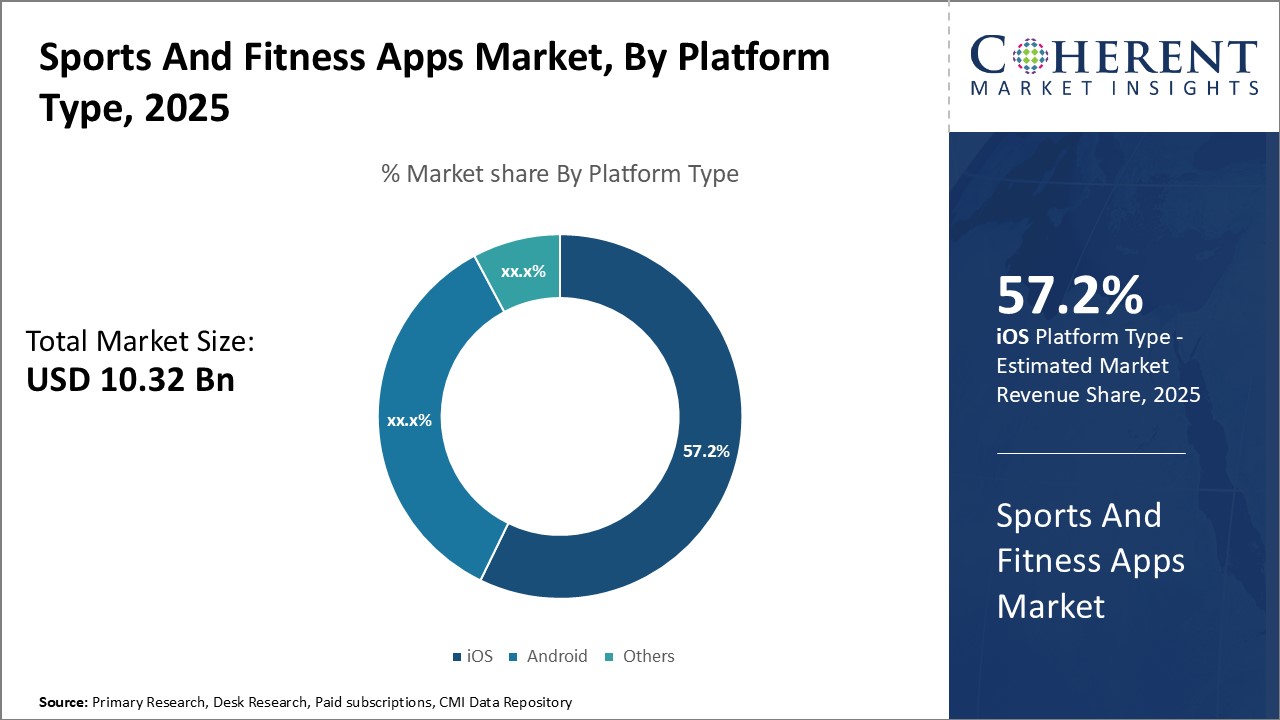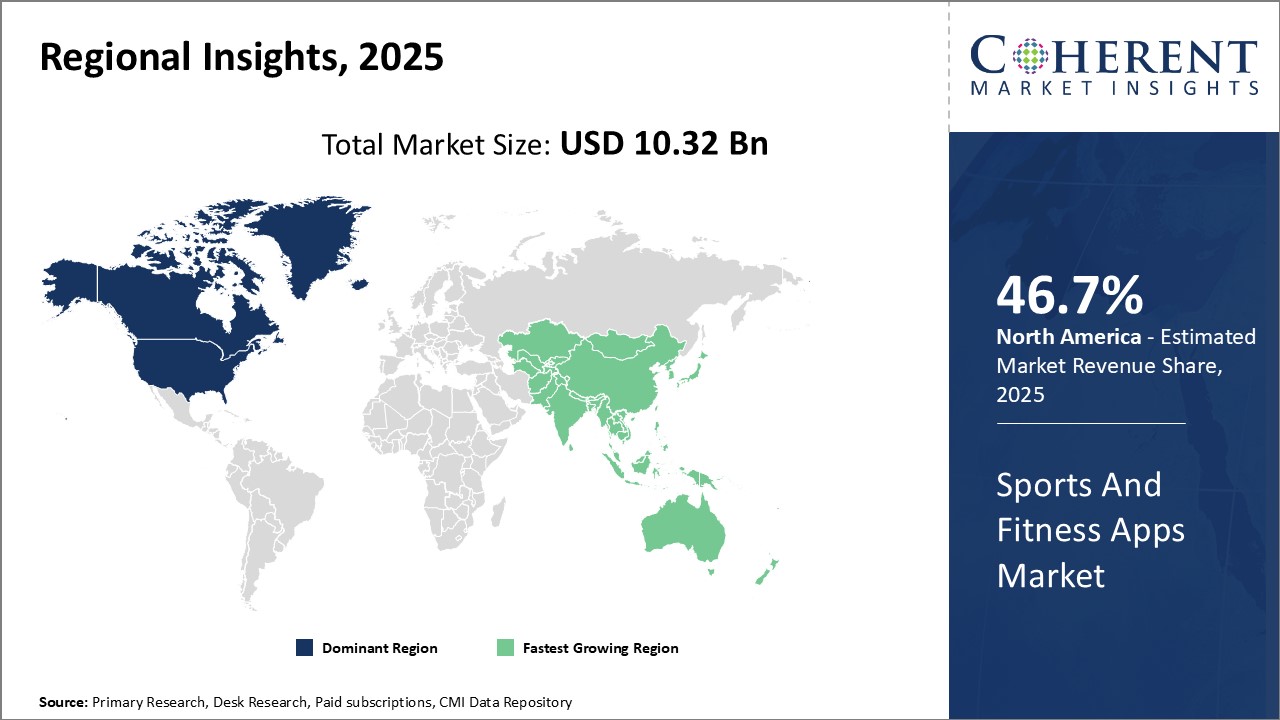The global sports and fitness apps market is estimated to be valued at US$ 10.32 Bn in 2025 and is expected to reach US$ 26.48 Bn by 2032, exhibiting a compound annual growth rate (CAGR) of 14.4% from 2025 to 2032.

Discover market dynamics shaping the industry: Request sample copy
The market is expected to witness significant growth over the forecast period. A variety of sports and fitness apps available across both iOS and android platforms is expected to drive the higher adoption of these apps. Integration of latest technologies like augmented reality, virtual reality, AI, and availability of affordable smart wearable devices are also expected to boost demand. Rising health awareness among people and increasing popularity of connected devices for tracking fitness activities are other major factors expected to support the growth of the global sports and fitness apps market between 2025 and 2032. However, data privacy and security concerns may hamper the industry growth to some extent over the coming years.
Rising awareness about fitness and health
With growing health issues like obesity, diabetes, and heart diseases, people are becoming more conscious about their fitness and health. They want to stay active and maintain a healthy lifestyle. This has increased the importance of exercising and being physically fit. At the same time, busy schedules and hectic work life leaves little time for people to spend on workouts at gym. This is driving the demand for convenient fitness solutions that can fit into their daily routine without much effort. Sports and fitness apps are proving to be a handy option in this regard. These apps offer a variety of workout plans, exercise regimes and training tips right on the smartphones. Users can choose exercises as per their skill level, physical condition and time availability. They can work out at home, in office or while traveling without any equipment. The growing awareness about health issues and benefits of regular exercise is compelling people to adopt such digital fitness tools for their daily health and workout needs. This rising focus on fitness is a key driver for the increasing popularity of sports and fitness apps.
For instance, in February 2021, Fitbit, a subsidiary of Alphabet Inc., announced a partnership with NASA to provide Fitbit devices as a ready-for-work solution to support the health and safety of NASA employees. This initiative aims to leverage Fitbit's wearable technology to collect resting heart rate data and other key health indicators from NASA personnel, enabling early identification of flu-like illnesses before the onset of symptoms.

Get actionable strategies to beat competition: Request sample copy
Convenience of using digital tools
Modern lifestyles are very fast paced and leave little room for traditional gym workout routines. People find it difficult to commute to gyms daily and spend hours there for exercise. At the same time, health consciousness is on the rise. This gap between the demand for fitness and constraints of daily schedule is fueling the demand for convenient digital solutions. Sports and fitness apps have emerged as a practical and hassle-free option to work out from any location at any time. With internet connectivity available at their fingertips through smartphones, users can access variety of exercises, workout programs, tutorials and real-time guidance from fitness experts through these apps. The exercises can be performed with or without equipment while travelling, waiting in line or even at home. Apps provide customized plans keeping in mind individual goals, preferences, and skill levels. Workouts can be scheduled as per daily routine and routines can be modified on the go. Apps help people stay active without disrupting their daily schedules and keeping track of their fitness journey. Their user-friendly features and convenience of use is a key driver for their increasing popularity as a mainstream fitness solution.
Key Takeaways from Analyst:
The global sports and fitness apps market has tremendous growth opportunities over the next five years. The rising health consciousness among consumers and growing popularity of wearable technology is expected to be a key driver for the market growth. As more people incorporate fitness tracking into their daily lives using smartwatches and dedicated fitness trackers, the demand for compatibility with sports and fitness apps will increase. This provides an opportunity for apps to utilize connected devices to enhance the user experience through features like activity tracking, goal setting, social connections, and others.
However, privacy and data security concerns surrounding personal health data collected by these apps may act as a restraint. App developers will need to focus on building user trust in their data handling practices. Another challenge is the highly fragmented market with numerous localized and niche apps. Dominating the market will require consolidation through strategic acquisitions to achieve scale. This concentration may curb opportunities for new entrants over time.
The North America region currently dominates the market but Asia Pacific is expected to grow the fastest, led by countries like India and China. This reflects the rising health awareness in emerging economies with younger demographic profiles.
Market Challenges: High subscription fees of premium apps
High subscription fees of premium sports and fitness apps is indeed restraining the growth of the Global Sports And Fitness Apps Market. When apps charge a hefty monthly or annual subscription, it discourages many potential users from signing up. This is because fitness and exercise have become more of a lifestyle option rather than just a necessity for some. So, users want to experiment with different types of workouts and routines without feeling the financial burden of subscriptions.
Charging a subscription, no matter how feature-rich the app, poses accessibility issues. Not everyone can afford to pay a recurring fee every month especially in the current economic climate where personal finances have been impacted for many due to job losses or pay cuts. This prevents those with less disposable income from experiencing the full benefits of these apps. Subscription fees put up a barrier that discourages people from maintaining an active fitness routine in the long run. Users are hesitant to commit to subscriptions as their priority needs and budgets may change frequently.
Market Opportunities: Integration of AR and VR in fitness apps
The integration of augmented reality (AR) and virtual reality (VR) in fitness apps provides a great opportunity to engage users and drive growth in the global sports and fitness apps market. AR and VR technologies allow users to try different workout routines, classes and fitness programs in an immersive virtual environment before committing to them. This enhances the user experience and makes fitness more enjoyable and accessible. Moreover, it helps users stay motivated through gamification features where they can compete against friends or other users globally in virtual challenges and leaderboards.
With AR, apps can also provide users with real-time feedback on their form and posture during exercises through the camera. Overlayed instructions and measurements keep users accountable and ensure they are doing the activities correctly to prevent injuries and achieve optimal results. In the future, as AR/VR hardware becomes more advanced, affordable and portable, users will be able to participate in live and on-demand group exercise classes and personal training sessions virtually from anywhere. This will appeal widely to time-constrained users and further fuel demand.

Discover high revenue pocket segments and roadmap to it: Request sample copy
Insights By Platform Type - Platform Popularity Drives iOS Dominance
In terms of platform type, iOS is expected to contribute 57.2% share of the global sports and fitness apps market in 2025 owing to its widespread adoption and app ecosystem popularity. As the operating system powering Apple's suite of iPhone, iPad, and iPod touch devices, iOS comes preinstalled on hundreds of millions of active devices worldwide. This large and loyal installed base of iOS users represents a huge potential target market for sports and fitness app developers.
Many factors have led to iOS's dominance in the platform space. Apple's emphasis on design, ease of use and curated experience has attracted users that expect a certain quality and functionality from apps. iOS also benefits from Apple's strict review protocols, ensuring that any app distributed through the App Store meets basic privacy, performance and security standards. This provides users confidence that fitness apps downloaded from the App Store will behave as intended.
Developing for iOS first is also highly strategic for app makers. With Apple controlling both the hardware and software aspects of the iPhone/iPad experience, the iOS audience is very homogeneous, making it easier to optimize apps. In contrast, the Android ecosystem is highly fragmented across different devices, configurations, and manufacturer customizations. Catering to this complex Android landscape requires more resources during development and testing.
The ability to seamlessly integrate with Apple services like HealthKit, HomeKit, and Music also gives iOS fitness apps powerful tools to enhance the user experience. Leveraging these APIs allows apps to offer innovative features centering around activity/health data, in-home workouts, and curated music/audio playlists. Such tight integration strengthens user lock-in within the iOS fitness app ecosystem. Looking ahead, iOS is positioned to maintain its sports and fitness apps market leadership given Apple's continued emphasis on privacy, quality of experience, and platform consistency.
Insights By Device Type - Ubiquity Fuels Smartphone Dominance
In terms of device type, smartphones is expected to contribute 54.6% share of the global sports and fitness apps market in 2025 owing to their ubiquitous nature and constant companion status. As the digital device people rely on most throughout the day, smartphones have become the ideal platform for tracking activity, monitoring health, and accessing varied fitness content on the go.
Smartphones are almost universally carried by individuals worldwide, accompanying them during all types of activity - whether exercising at the gym, going for a run outside, or engaging in household chores. Their ubiquitous presence means health and activity tracking can occur seamlessly throughout the day without requiring users to tediously log-in to different devices. Notifications and reminders from fitness apps also reliably reach users on their smartphones.
Smartphone apps also leverage the built-in sensors found on modern devices. Using the accelerometer, gyroscope, GPS, heart rate monitor and other inputs, fitness apps can unobtrusively track movements, location, vital signs and more without any additional wearables. The rich suite of smartphone capabilities from the camera to maps further enrich the app experience through features like meal/exercise photo logging and route planning.
Looking ahead, as 5G connectivity and more powerful AI/AR capabilities are added to smartphones, the potential for immersive, personalized virtual coaching and gamified workout experiences will further strengthen this device’s popularity for sports and fitness apps. Smartphones allow individuals to effectively integrate activity tracking seamlessly into busy lifestyles, cementing this device type’s dominance in the market.
Insights By Application Type - Weight Management Drives Exercise & Diet App Usage
In terms of application type, exercise and weight loss is expected to contribute 39.7% share of the global sports and fitness apps market in 2025 driven by the widespread desire for improved health and physical appearance. As obesity rates climb worldwide amid busy modern lifestyles, individuals increasingly turn to digital tools and communities for guidance in managing their weight and transforming behaviors long-term.
Weight loss apps become especially useful during New Year resolutions or post-holiday weight gain periods when motivation peaks. By providing structured meal plans, calorie counting tools and customized workout routines, these apps empower users to easily track intake and output. Social features also encourage accountability and completion of challenges through public leaderboards and group activities. Some apps take a gamified approach with virtual badges and leveling up to maintain engagement.
As scientific understanding of nutrition evolves rapidly, diet and weight management apps stay on the cutting edge. Through database updates complemented by personalized coaching, users receive guidance incorporating the latest research around macros, diets like keto/paleo, intermittent fasting, etc. Sleep and stress tracking further integrates a holistic view of factors influencing the weight journey.
Over time, as individuals realize weight control requires lifetime habit change vice temporary fixes, exercise and nutrition apps aim to cultivate self-sufficiency. Through increasingly immersive coaching experiences leveraging AR/VR, these apps aspire to become true digital wellness advisors. Their growing capabilities and communities will continue propelling this application segment’s market dominance.

Need a Different Region or Segment? Customize now
North America has firmly established itself as the dominant region in the global sports and fitness apps market. The region is expected to account for 46.7% of the market share in 2025. Home to innovative app developers and tech companies, the U.S. in particular has pioneered many of the most popular sports and fitness-focused apps available today. The large and active consumer base in the region has allowed various niche workout and tracking apps to gain widespread adoption. The presence of industry leaders like Nike and Fitbit has made North America a leader in smart sportswear and wearable technologies that integrate with companion apps.
The region's emphasis on health and wellness makes consumers open to new digital services that let them manage and monitor their workouts anytime, anywhere. Sports networks and event organizers in North America have also launched well-attended apps and online communities for enthusiasts to stay connected to their favorite sports teams and leagues throughout the year. Collaborations between fitness device makers, sports franchises, and streaming platforms are strengthening the regional ecosystem around activity and workout-focused apps.
Asia Pacific has emerged as the fastest growing regional market for sports and fitness apps. While North America set the standards early on, Asian countries are rapidly catching up, investing in both local development and foreign partnerships. Countries like India and China in particular have massive and rapidly expanding populations of tech-savvy young consumers eager to adopt health and workout apps. With smartphone adoption continuously rising across socioeconomic classes, app-based fitness solutions are uniquely poised to meet the growing wellness demands of Asia Pacific's burgeoning middle class.
Many international app developers and wearables brands have prioritized expansion into major Asian markets like Japan, South Korea and Southeast Asia in order to tap into the region's growth potential. Localized content, pricing strategies and advertising partnerships have helped popular Western apps achieve faster adoption rates here than in other emerging markets. The active involvement of governments, gyms, sports bodies, and insurance providers in promoting preventive healthcare benefits this regional market for digital fitness tools as well.
Sports And Fitness Apps Market Report Coverage
| Report Coverage | Details | ||
|---|---|---|---|
| Base Year: | 2024 | Market Size in 2025: | USD 10.32 Bn |
| Historical Data for: | 2020 To 2024 | Forecast Period: | 2025 To 2032 |
| Forecast Period 2025 to 2032 CAGR: | 14.4% | 2032 Value Projection: | USD 26.48 Bn |
| Geographies covered: |
|
||
| Segments covered: |
|
||
| Companies covered: |
Adidas AG, Appster, Azumio Inc., Fitbit Inc., FitnessKeeper (RunKeeper), Fooducate, Google LLC, JEFIT Workout Tracker, Kayla Itsines, MyFitnessPal Inc., Nike, Inc., Noom Inc., Polar Electro, Sworkit, and Under Armour, Inc. |
||
| Growth Drivers: |
|
||
| Restraints & Challenges: |
|
||
Uncover macros and micros vetted on 75+ parameters: Get instant access to report
*Definition: The global sports and fitness apps market refers to the worldwide market for mobile applications and software designed to help individuals track, monitor, and improve their physical fitness, health, and athletic performance. These apps leverage advanced technologies like artificial intelligence, IoT, and machine learning to provide personalized workout plans, diet charts, step-tracking, access to personal health coaches, and equipment-free exercise routines.
Share
Share
About Author
Ankur Rai is a Research Consultant with over 5 years of experience in handling consulting and syndicated reports across diverse sectors. He manages consulting and market research projects centered on go-to-market strategy, opportunity analysis, competitive landscape, and market size estimation and forecasting. He also advises clients on identifying and targeting absolute opportunities to penetrate untapped markets.
Missing comfort of reading report in your local language? Find your preferred language :
Transform your Strategy with Exclusive Trending Reports :
Frequently Asked Questions
Joining thousands of companies around the world committed to making the Excellent Business Solutions.
View All Our Clients
US Reciprocal Tax Impact Analysis On Sports And Fitness Apps Market
Stay updated on tariff changes with expert insights and timely information